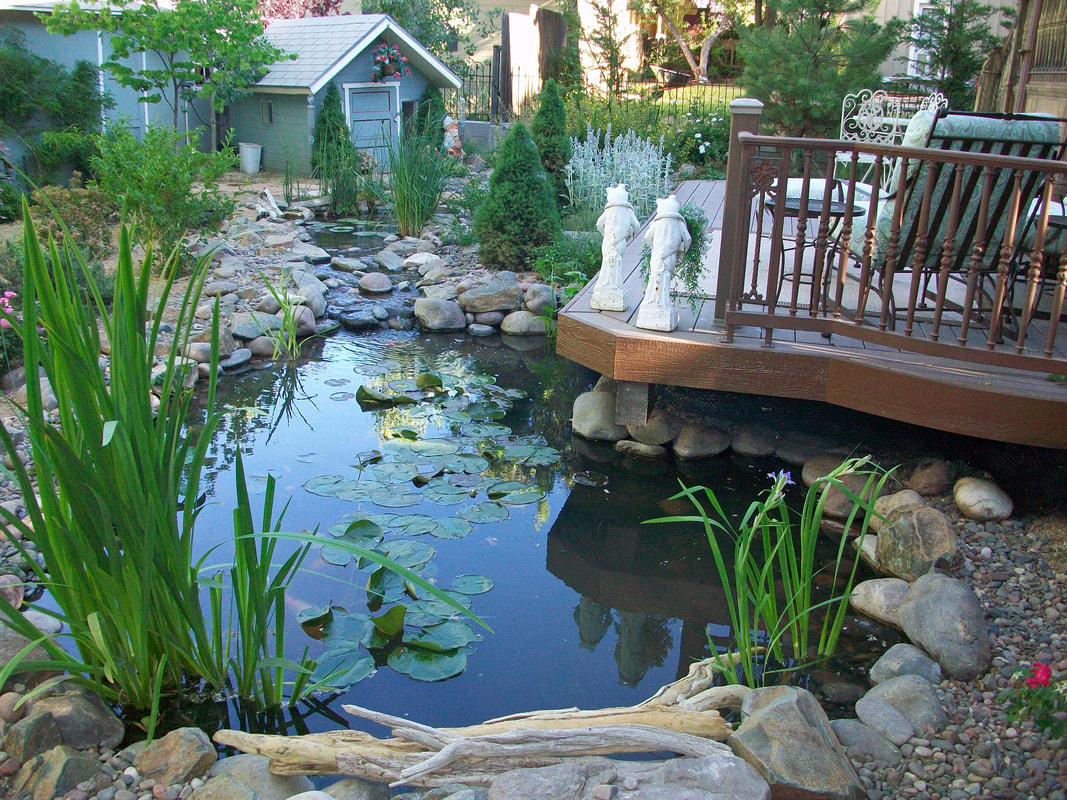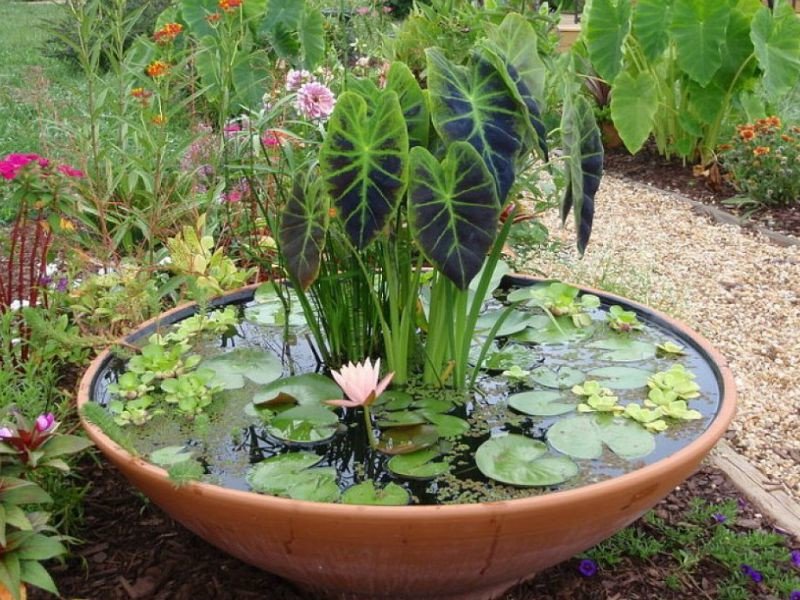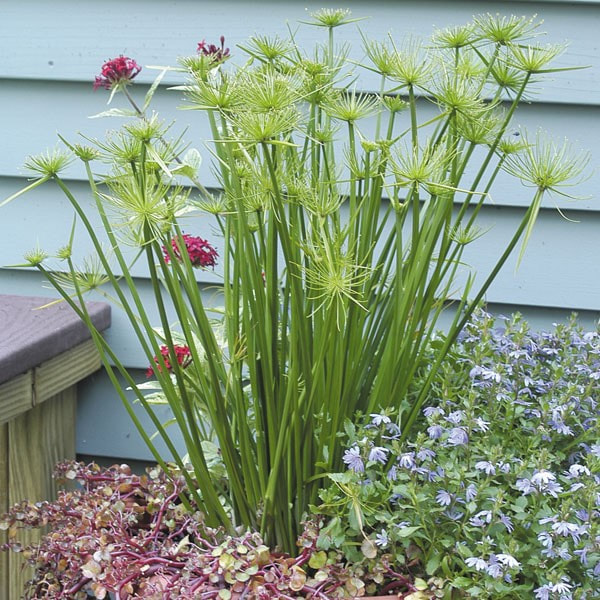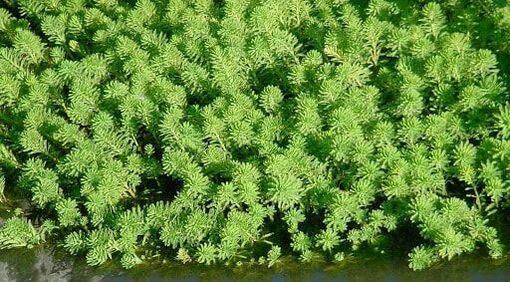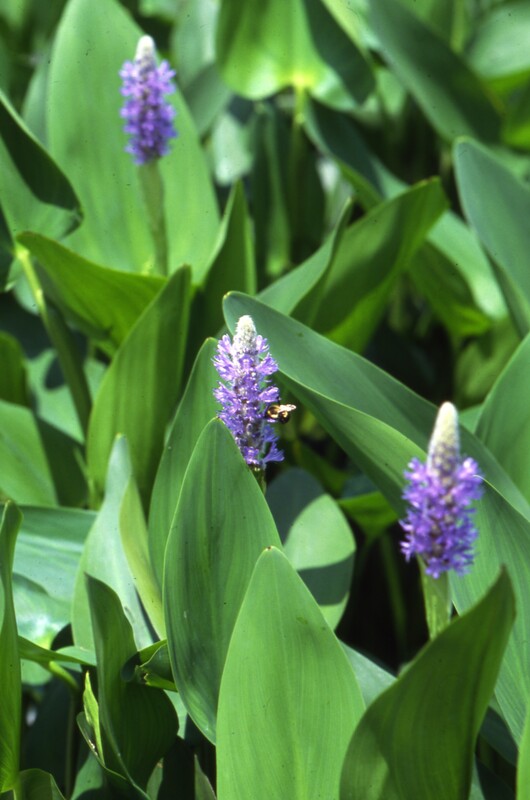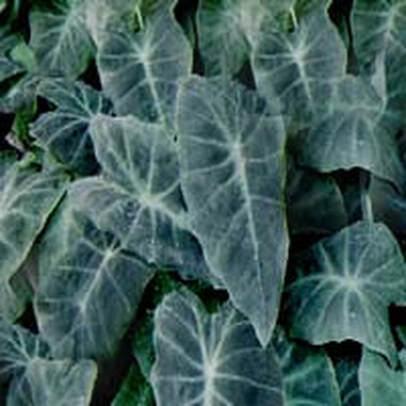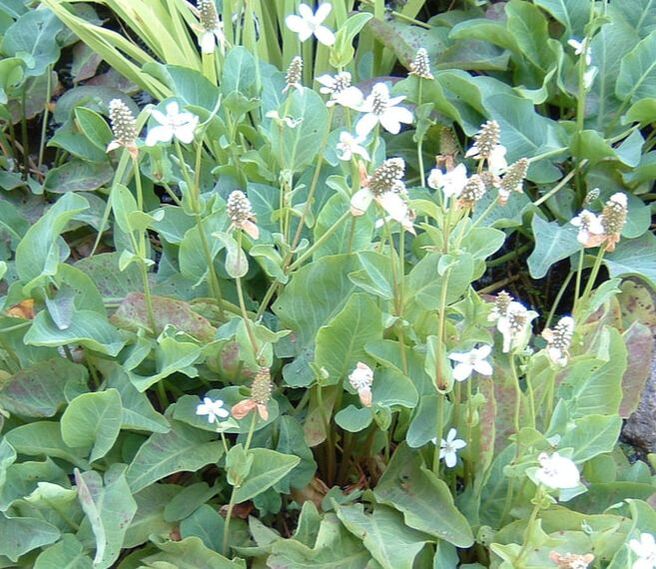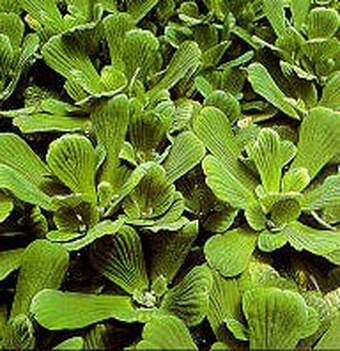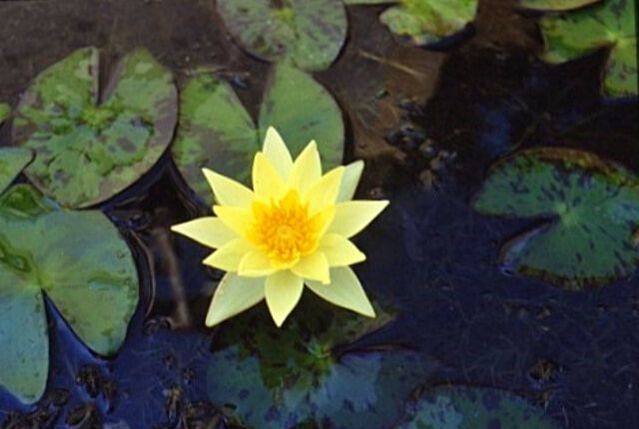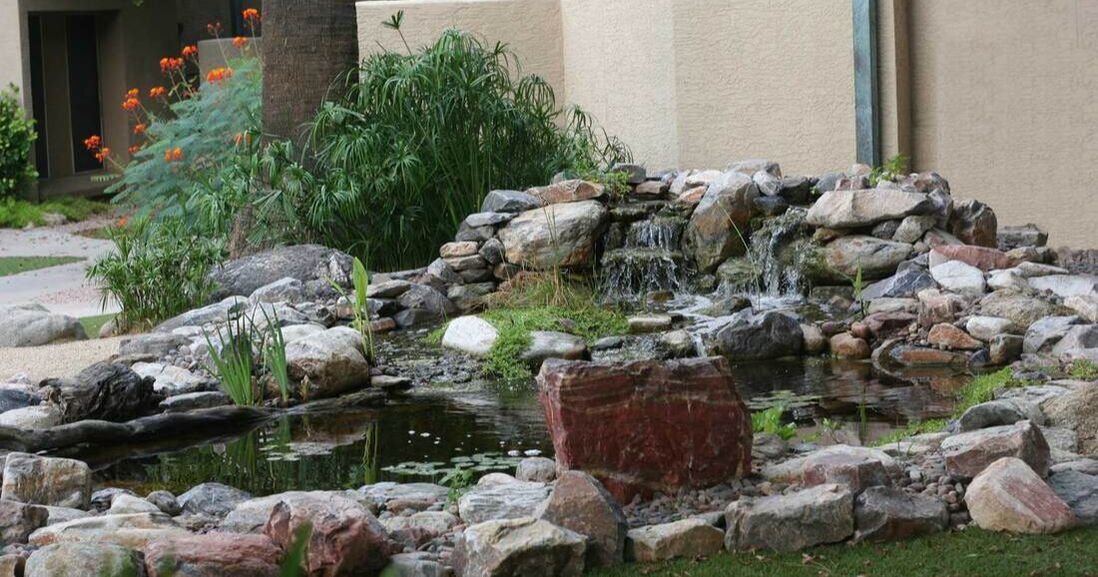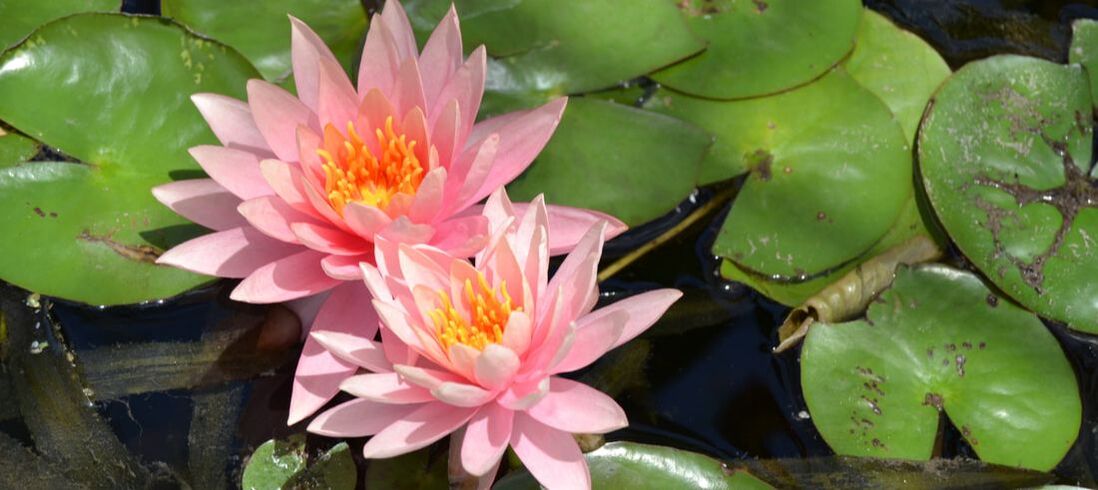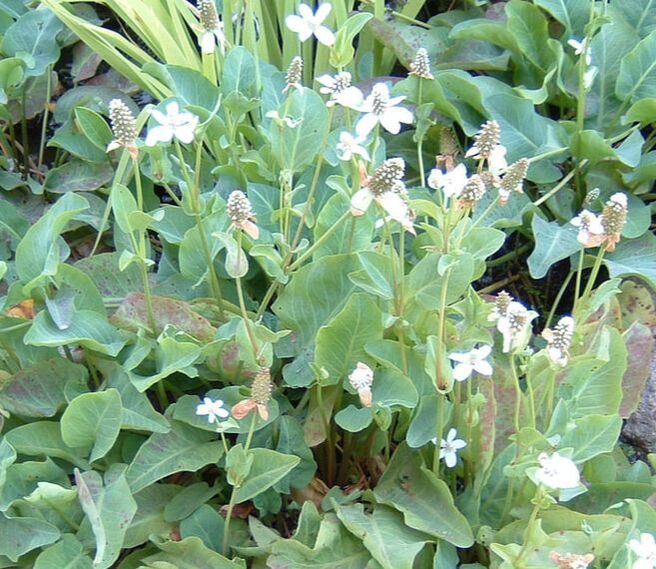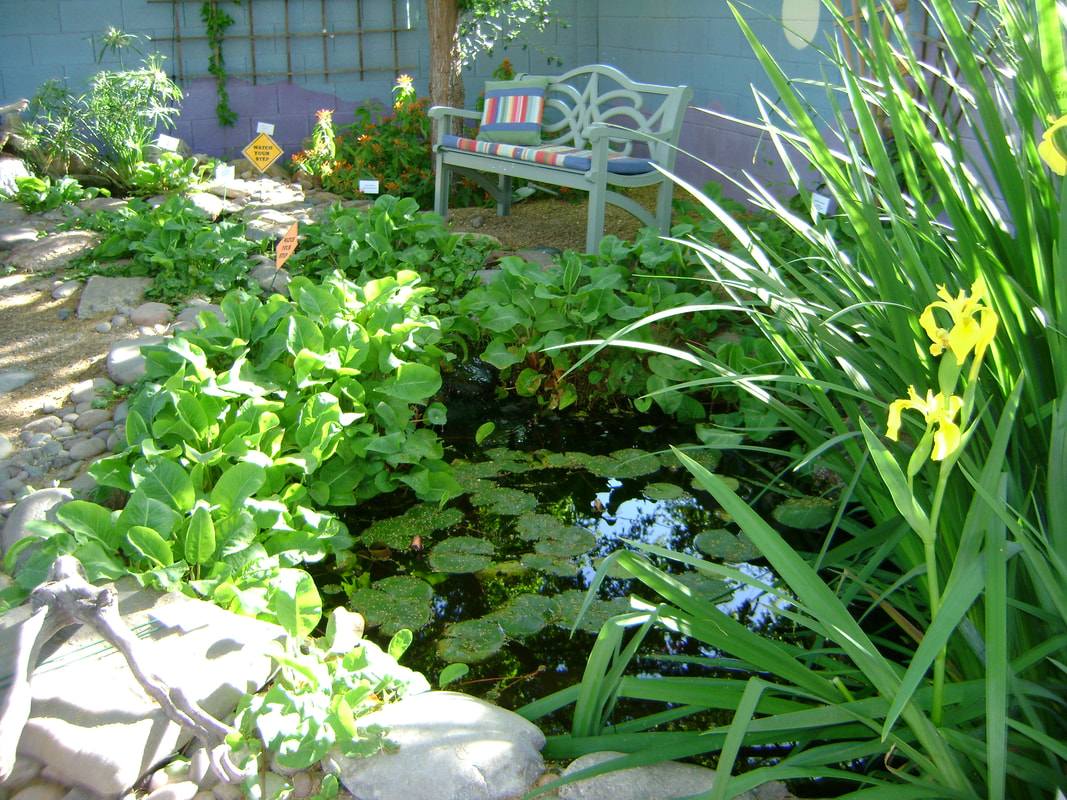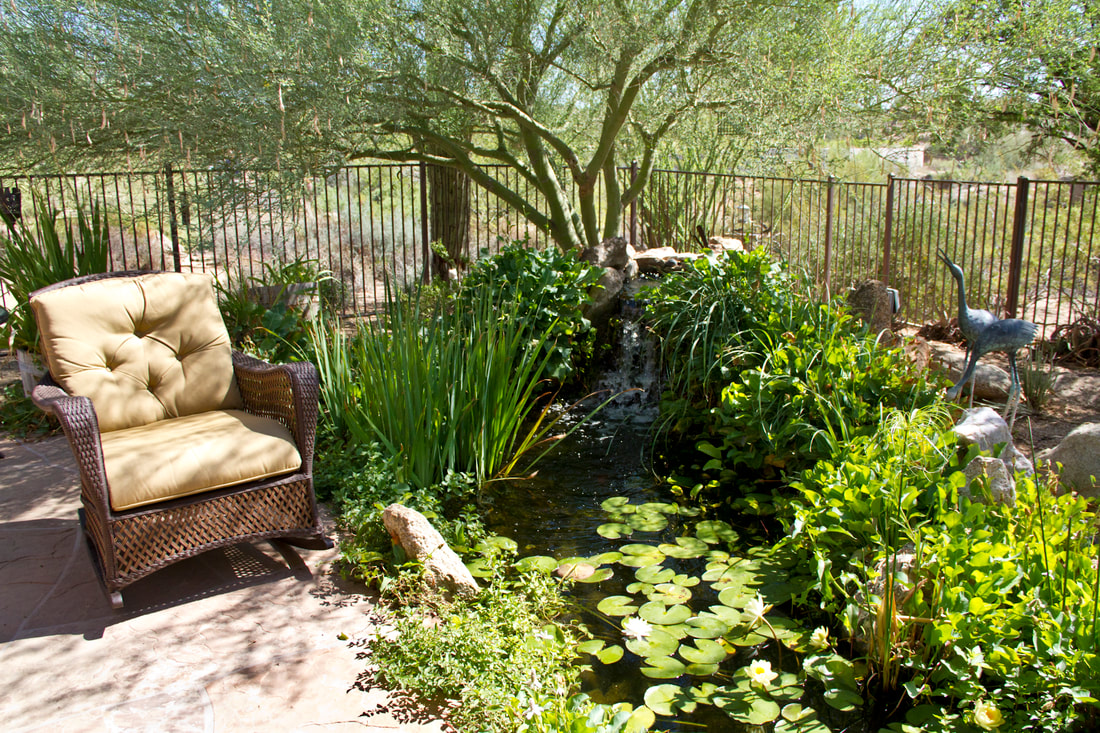How do I find a leak in my Ecosystem Pond? Many times what people think is a leak in their backyard pond is actually a water displacement issue with the waterfall or stream. Or it could simply be a malfunctioning autofill device. OR, in May and June, which are our hottest, driest months, it could very well be evaporation at its finest. When a leak really isn't a leak: 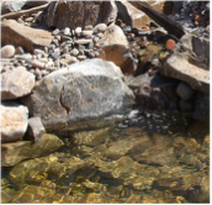 Remember that water wicks up the side of the rocks in your pond, so be sure you are actually seeing a drop in water, and not just wicking action. If the autofill device is not running at more than a drip, then you don't have a leak. Phoenix pond leak troubleshooting steps Before spending money for someone else to find the problem, here are some simple things you can do to troubleshoot the issue. Heck, you may even be able to fix it yourself and save some money! Turn off the water supply to the pond and unplug the pump, monitoring the water loss overnight. If the water level does not drop any further, you know the "leak" is in the waterfall or stream, and is more likely than not the result of plants needing to be thinned, or another displacement issue like shifting rocks on the edge of your liner due to some settling. Aquatic plants need thinning in a Phoenix pond or stream! 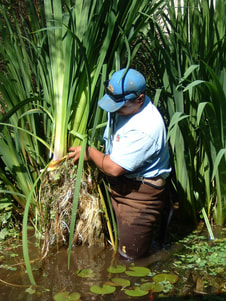 This is an easy fix with a living ecosystem pond built using EPDM rubber. Use an appraising eye to evaluate whether or not your stream is packed full of plant roots. If you've just been trimming off the dead leaves and not actually thinning the root material, chances are, you've located your issue. Sometimes you have to be brutal and thin those babies good! Just don't do this during winter when there's a chance that an upcoming frost will kill what's left of the plants. Settling leak around the edges of a Phoenix pond 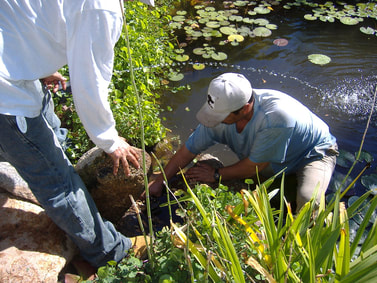 Once that is done, check around the edges to make sure that water is still not going over the side of the liner. If it is, then you may have a settling leak. Again, this is an easy fix. Move some rocks out of the way, lift the liner up, shove some dirt under it, and replace the rock. Viola! Problem solved. The leak is in the waterfall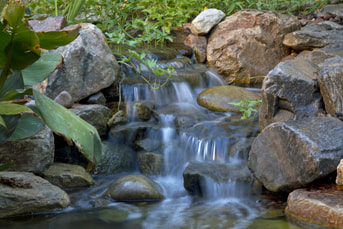 If the previous two steps didn't solve the problem, then the leak is somewhere in the waterfall, and you should call your contractor to come deal with it, unless you're really handy and know what you're doing. Make sure that the flow over the falls is not being impeded by plants that have shifted into position. This sometimes causes a dam, causing water to flow off the back of the waterfall instead of the front. The leak is in the pond 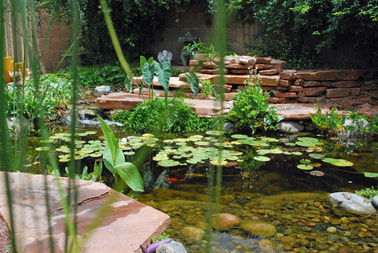 If the water continued to drop despite the waterfall being turned off, go ahead and turn the system back on to keep it oxygenated for your fish if it's summertime, and call your contractor for help. You may be advised to turn the waterfall back off and let it drop until it stops so that the hole or tear can be quickly addressed. MORE POSTS YOU MIGHT ENJOY: RODENTS AND THE PHOENIX POND CONTROLING PLANTS IN A PHOENIX POND WILDLIFE AROUND A PHOENIX POND NEED MORE HELP?Container water gardening is a rapidly-growing garden hobby and provides a whole new opportunity for an exciting group of plants. Not to mention, you can even add small fish to your aquatic container, thereby creating your very own mini pond to enjoy without having to pick up a shovel. These mini ponds are fabulous for folks who don't have a whole lot of space, like condos and townhouses, etc. Plants are what makes your container water garden a garden. They add interest, texture, and a splash of color to the spot you choose for your mini pond. They also help keep the water clear of algae, while providing perching spots for birds that seek out the water. To make choosing plants easier, we’re sharing our list of favorite aquatic plants for mini ponds. And what’s more – you can add any of these plants to any pond, large or small! Dwarf PapyrusCyperus isocladus Feathery heads on sturdy green stalks create a striking vertical element in container water gardens. Dwarf papyrus enjoys a little shade but can take full sun, too. Use this charmer as an annual in colder climates. Parrot FeatherMyriophyllum brasiliense Feathery lime green foliage on vibrant red stems creates a mat that will spill over the edge of your container. It grows 3” to 4” tall and is a great choice for both small ponds and container water gardens. Place it in full sun to part shade. And keep it pinched back to make it grow fuller. Pickerel RUSHPontederia cordata Add a bit of height and color to your mini pond with the impressive pink or purple pickerel rush plant. This easy-to-grow aquatic plant rewards you with bright blue flowers atop lush green foliage. Prefers full sun to part shade and grows 24” to 30” tall. Taro, Green or BlackColocasia ‘Fontenessii’ Glossy green leaves on deep purple stems add a stunning effect to your container water garden. Each leaf is a work of art atop 36” high stems. Choose Taro when you want an especially tall plant for your container. Enjoys full shade in Phoenix. Available in standard green or black (pictured below). Yerba MansaAnemopsis californica Looking for a smaller plant that blooms all summer? Look no further than this dainty white flower with a cone-shaped center. As they age, the flowers get pink spots. This plant is actually an Arizona canyon native plant. The Native Americans use it in a tea form to relieve digestive issues. Water LettucePistia stratiotes Soft and velvety, this floating plant performs best in shady to partly sunny locations. Each “flower” sends out shoots to create more rosettes. If your container gets crowded, simply thin them out. Helvola WaterlilyNymphaea ‘Pygmaea Helvola’ Helvola is the smallest of all the hardy waterlilies with delightful 2” to 3” star-shaped blooms and heavily mottled 1” to 2” pads. Prefers full sun to partial shade and blooms all summer long This is by no means an exhaustive list, but these can get you started off on the right foot. Check out our page on pond plants for your backyard! OTHER POSTS YOU MIGHT ENJOY: CREATE A BACKYARD SANCTUARY WITH JAPENESE WATER FEATURES WHY BACKYARD WATER FEATURES HAVE HEALING POWER PONDING: KEEPIT SIMPLE, NOT STUPID READY FOR YOUR OWN BACKYARD WATER FEATURE?Water gardening and ponds have become popular trends in home yard design over the last several years, and their popularity as a home improvement is gaining ground every day. The backyard pond has become the favorite space outside the house for relaxing alone, with the family, or entertaining friends. Similar to having a swimming pool in your backyard, there’s more to having a pond than simply digging a hole, filling it with water, dropping in a few fish and surrounding it with some greenery. Some basic pond maintenance is essential to the longevity of your water garden. A little regular pond care and the installation of pond filtration systems will keep your backyard oasis thriving and beautiful for many years of enjoyment. 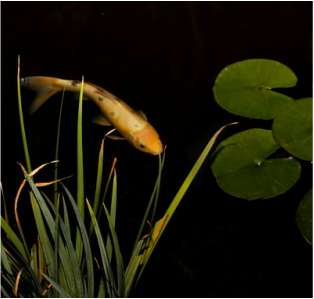 Pond maintenance can be low once you understand the basics. The main concept for maintaining a healthy pond is the understanding that caring for your pond requires managing animal and plant waste, such as fish excrement and the growth of algae. Rivers and streams naturally renew themselves with nutrients and fresh water; however, a man-made pond is a closed ecosystem. This means that nothing is organically added in or taken out by natural outside forces (except for maybe that ocassional dust storm). For successful pond maintenance, manual intervention is necessary to take care of what nature isn’t and to keep the ecosystem of the pond in balance. In a closed pond system, as opposed to an open, natural ecosystem, waste and algae needs to be equalized, and for this reason a proper biological and mechanical pond filtration system is needed. By caring for your pond, filtering out organic materials and not letting them break down and decay in the water, a healthy balance will be maintained in the pond. The best way to ensure a healthy pond is by installing a pond filtration system. A professional pond designer/builder will install a filtration system that is adequate for the size of the pond you have, and add appropriate water plants to help with the filtration process. OTHER POSTS YOU MIGHT ENJOY: GREAT WATER FEATURE IDEAS CREATE A BACKYARD SANCTUARY WITH JAPANESE WATER FEATURES SUSTAINABLE PHOENIX PONDS Aquatic plants are a very important step in achieving a truly balanced ecosystem pond. Regardless of why you got into the water gardening hobby, adding aquatic plants to the pond is an important part of the water garden. They provide beauty and naturalization with a huge array of plant choices. Most importantly, they help balance the pond’s ecosystem, as well as provide valuable biological filtration that removes nitrogen, ammonia, nitrates and other minerals from pond water. These excess nutrients are often the cause of unsightly water conditions. The end result helps to minimize pond maintenance, leaving more time to enjoy your pond. Without aquatic plants, your pond would not be able to function as a complete ecosystem. Pond Plants in a Backyard Koi PondAquatic plants can be classified into a few main categories: water lilies, marginal plants, floaters and submerged (also known as oxygenators). Plants can also be put into two basic types known as “tropical” and “hardy.” Hardy plants will over-winter in colder climates and tropical plants are more suited to warmer climates, although tropical plants are often used as annuals in colder climate zones. Water Lilies Water lilies are among the most popular of aquatic plants and are often the centerpiece of the water garden. A water garden never seems complete without a few beautiful water lilies. Not only are water lilies breathtaking, but they provide valuable shade (a respite from our summer heat), which helps to keep the pond cool while providing refuge for pond fish. Ideally, only thirty to fifty percent of the water surface should be covered with aquatic plants. Marginals The marginal plant group is the largest aquatic plant group by far, containing both hardy and tropical plants. Marginal plants serve many functions such as adding beauty and providing valuable filtration. They are called “marginals” because they typically grow around the edges or “margins” of a pond or lake. Marginal plants thrive in wet soil or standing water that covers the crown or base of the plant by as little as two inches and up to as much as six inches. Some examples of marginals include Yerba manza and Creeping Jenny. 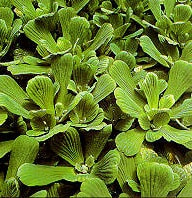 Water Lettuce Water Lettuce Floaters Floating plants do just as their name indicates: they float on the water’s surface. Their roots dangle beneath the plant absorbing all their nutrients from the water. Most floating plants do a great job of filtering ponds by removing nutrients directly from the water, as opposed to the rock substrate where most other aquatic plants are situated or planted. Submerged Like the name implies, this group of plants lives below the water surface. They are commonly referred to as oxygenators. Submerged aquatics do produce oxygen during most of the day. Submerged aquatic plants live entirely under water, almost. Some oxygenators bloom and the flowers often rise to the surface. They include plants such as elodea, anacharis, hornwort, foxtail, cabomba, and vallisneria. For the most part, submerged plants absorb their nutrients directly from the water. This means they compete with algae for nutrients, thereby helping to balance the ecosystem. 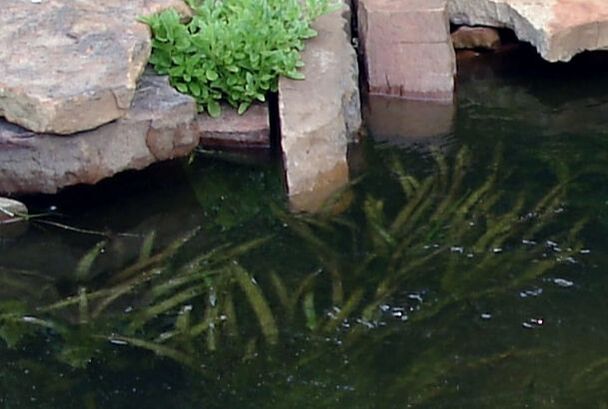 Vallisneria in a pond by The Pond Gnome Vallisneria in a pond by The Pond Gnome Putting it All TogetherJust like their soil counterparts, a good mix of aquatic plants lends the best visual impact for your water garden. Marginals help to blend the pond into the surrounding landscape, while water lilies provide pops of color at the water’s surface. Take some time to familiarize yourself with all the wonderful options out there and you’ll soon find what most appeals to you. For your convenience, we have a page on our website dedicated to the aquatic plants that we know work well in our Sonoran Desert. OTHER POSTS YOU MIGHT ENJOY:
WATER FEATURES HAVE HEALING POWER PONDS HAVE MEASURABLE VALUE GUPPY GRASS: FRIEND OR FOE? Did you know there’s a scientific reason why a shower feels so refreshing? It’s the same reason why people flock to lakes, oceans, and waterfalls for vacations. Falling water from fountains, waterfalls, and even your morning shower releases negative ions into the surrounding atmosphere. And these ions have a profound effect on our physical well-being! When you’re in an environment where the concentration of negative ions is greater than positive ions, it will have a positive effect on your body, mind, and spirit. There’s an increase in blood flow and oxygen content to your cells; it lowers blood pressure and stabilizes respiration creating a calming effect. Increased oxygen content in your blood is critical for all metabolic functions which in turn effects your mood. Hospital patients who have a view of natural landscapes recover faster from surgery and require less pain medication. In addition, heart rate, blood pressure, and other measures return to normal levels more quickly when people view natural rather than urban landscapes after a stressful experience. The Sustainable Sites Initiative. Standards and Guidelines: Preliminary Report. It’s no secret that water features provide soothing sights and sounds that help you relax and de-stress in today’s busy world. Now more than ever, we need the healing effects that water provides. Whether you’re dealing with stress, illness, or simply wish to improve your overall outlook on life, consider adding a pond, waterfall, or fountainscape to your outdoor living space. Experts agree it can be extremely therapeutic! As landscape architects and experts in healing garden design, we specify water features in most of our projects. We’ve had great success with using the Aquascape product line. Their natural pond systems fit perfectly into our design solutions and offer our clients a sustainable solution that adds a positive distraction to the healthcare environment. We also design water features in unusual locations like roof decks. Aquascape sculptural water displays add a nice balance to the healing garden aesthetic. Geoff Roehll, Senior Vice President, Hitchcock Designs Our patients and their families find peace and tranquility when visiting our beautiful water features. We receive a great deal of positive feedback on the addition of the water gardens to our facility. Even the staff and board members have found the water features to be beneficial for relieving stress and improving their daily outlook. Nancy Vance, Executive Director, Living Well Cancer Resource Center Ready to get your own piece of paradise?MORE POSTS YOU MIGHT ENJOY:
PHOENIX PONDS HAVE MEASUREABLE VALUE SELECTING KOI THE VALUE OF PROFESSIONAL POND MAINTENANCE |
The Pond Gnome offers Pond Design, Pond Construction, Pond Maintenance, Pond Remodeling, Pond Replacement, and Pond Cleaning Services for the Greater Phoenix Metropolitan area, including the cities of Phoenix, Scottsdale, Paradise Valley, Carefree, Cave Creek, Glendale, Peoria, Sun City, and other surrounding communities.
Our Services |
Company |
|
